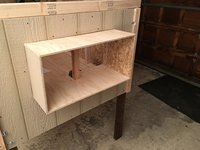- Thread starter
- #61
bjmoose
Songster
Progress is going to slow down now, with the holiday over and back at my day job.
Honestly, I thought the build would be further along by now. But, everything always takes longer than you think.
Today after work, I hung the left side door. If you look closely, you'll see I had to shim out the bottom hinge.

And, as predicted, the double doors don't line up perfectly.

Honestly, I thought the build would be further along by now. But, everything always takes longer than you think.
Today after work, I hung the left side door. If you look closely, you'll see I had to shim out the bottom hinge.
And, as predicted, the double doors don't line up perfectly.






